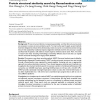Free Online Productivity Tools
i2Speak
i2Symbol
i2OCR
iTex2Img
iWeb2Print
iWeb2Shot
i2Type
iPdf2Split
iPdf2Merge
i2Bopomofo
i2Arabic
i2Style
i2Image
i2PDF
iLatex2Rtf
Sci2ools
135
click to vote
BMCBI
2007
2007
Protein structural similarity search by Ramachandran codes
Background: Protein structural data has increased exponentially, such that fast and accurate tools are necessary to access structure similarity search. To improve the search speed, several methods have been designed to reduce three-dimensional protein structures to one-dimensional text strings that are then analyzed by traditional sequence alignment methods; however, the accuracy is usually sacrificed and the speed is still unable to match sequence similarity search tools. Here, we aimed to improve the linear encoding methodology and develop efficient search tools that can rapidly retrieve structural homologs from large protein databases. Results: We propose a new linear encoding method, SARST (Structural similarity search Aided by Ramachandran Sequential Transformation). SARST transforms protein structures into text strings through a Ramachandran map organized by nearest-neighbor clustering and uses a regenerative approach to produce substitution matrices. Then, classical sequence si...
Related Content
| Added | 12 Dec 2010 |
| Updated | 12 Dec 2010 |
| Type | Journal |
| Year | 2007 |
| Where | BMCBI |
| Authors | Wei-Cheng Lo, Po-Jung Huang, Chih-Hung Chang, Ping-Chiang Lyu |
Comments (0)

